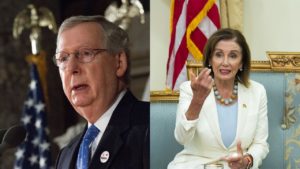
(L) Sen. Mitch McConnell, March 25, 2014. USDA photo by Lance Cheung. (R) Rep. Nancy Pelosi, July 28, 2019. Official U.S. Embassy photograph by: Archibald Sackey and Courage Ahiati.
What did the long delay in the rescue package accomplish? Despite delaying “much-needed aid for days, while businesses closed and people died,” little was accomplished. The new deal is much the same as the old deal, based on the just-released draft, explains Christopher Bedford at The Federalist.
Here’s what is included:
- Direct payments: Americans will receive a one-time direct deposit of up to $1,200, and married couples will get $2,400, plus an additional $500 per child. The payments will be available for incomes up to $75,000 for individuals and $150,000 for married couples. This is true even for those who have no income, as well as those whose income comes entirely from non-taxable means-tested benefit programs, such as Social Security.
- Use of retirement funds: The bill waives the 10% early withdrawal penalty for distributions up to $100,000 for coronavirus-related purposes, retroactive to Jan. 1.
- Small businesses will get $367 billion in loan guarantees to keep making payroll while workers have to stay home. Companies with 500 employees or less that keep paychecks steady could get up to $10 million each in forgivable small business loans.
- The unemployed: The program’s extended unemployment insurance program — “unemployment on steroids,” as Chuck Schumer calls it — expands eligibility and offers workers an additional $600 per week for four months, on top of what state programs pay. It also extends UI benefits through Dec. 31, and allows furloughed workers to stay on as employees. The deal extends to gig economy workers.
- Hospitals and health care workers: The deal injects $100 billion into hospitals and the nation’s health system, and billions more into providing personal and protective equipment for health care workers, testing supplies, and increased workforce and training.
- Coronavirus testing: All testing and potential vaccines for COVID-19 will be covered at no cost to patients.
- Large corporations: $500 billion will be allotted to provide loans, loan guarantees, and other investments, overseen by a Treasury Department inspector general. These loans will not exceed five years and cannot be forgiven.
- Airlines will receive $25 billion (of the $500 billion) for passenger air carriers, and $4 billion for cargo air carriers.
- Payroll taxes: The measure allows individuals to defer payment of their 2020 payroll taxes until 2021 and 2022.
- States and local governments will get $150 billion, with $8 billion set aside for tribal governments.
- Agriculture: The deal would increase the amount the Agriculture Department can spend on its bailout program from $30 billion to $50 billion, according to a press release issued by Sen. John Hoeven (R-N.D.).
Outrageously, Speaker Pelosi has demanded new airline emission standards as part of the deal.
P.S. In the Age of Coronavirus: a Homemade Throat Sanitizer.
P.P.S. If you can’t find hand-sanitizer, you can make your own.
If you’re willing to fight for Main Street America, click here to sign up for the Richardcyoung.com free weekly email.




